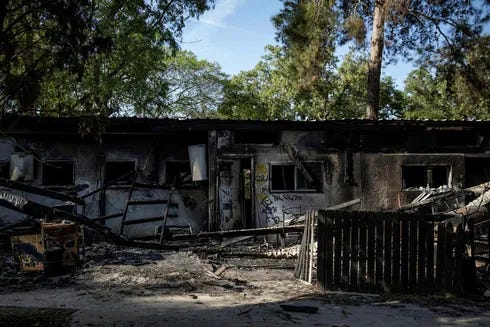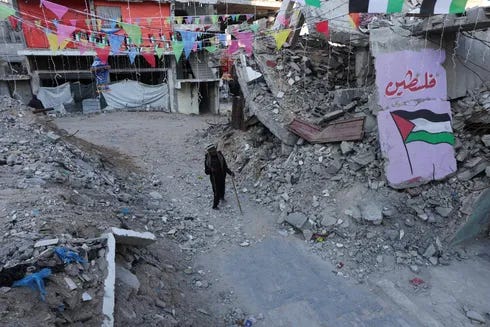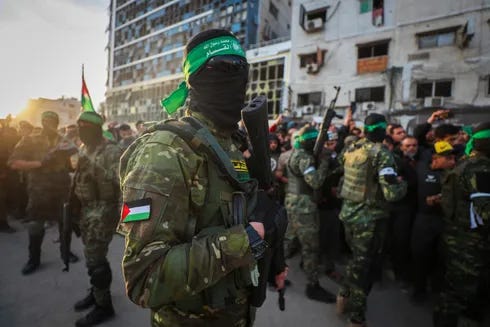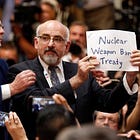"The IDF's Landmark Oct. 7 Probes Reveal Only Part of Israel's Failure – a State Inquiry Must Follow" by Amos Harel
"The October 7 disaster wasn't just the result of mistaken decisions that night, but stemmed from years of failures."
The following is a reposting of an interesting analysis by Amos Harel as published by Haaretz on February 28th.
You will note that the fact Israel invoked their Hannibal Directive on October 7, 2023 is not mentioned at all in this report. I have linked the articles I have previously posted about Israel’s Hannibal Directive at the end.
Please note that this blog exceeds the maximum length that can be read by email. Please click on the title below to read it in full on Substack. Thank you.
The IDF's Landmark Oct. 7 Probes Reveal Only Part of Israel's Failure – a State Inquiry Must Follow
The October 7 disaster wasn't just the result of mistaken decisions that night, but stemmed from years of failures. Chief among them: the political conception of Hamas as an Israeli asset, the intelligence misjudgment that it couldn't launch a large-scale attack, and weak defensive deployment
Protestors in Tel Aviv on Thursday night.Credit: Itay Ron
By Amos Harel • Harretz
Feb 28, 2025 6:01 am IST
This has been one of the most difficult weeks Israeli society has endured since the war began. The return of the hostages' bodies, following the moving images of hostages who came back alive reuniting with their families in the previous weeks, seemed to envelop the whole country in a thick cloud of melancholy. Tens of thousands joined the funeral procession of the Bibas family from Kibbutz Nir Oz – Shiri, the mother, and her children Kfir and Ariel. Many more watched on television.
The weekly shows of insensitivity by coalition members, who keep going about their business as though the tragedy barely touches them, only intensified the grief. Prime Minister Benjamin Netanyahu outdid them all. One minute he's waving pictures of the mother and the children in the Knesset and scattering details about their appalling murder in captivity, totally ignoring the family's request that he refrain from doing so. Two days later, he shows up in court wearing an orange tie and asks the judges to start the proceedings with a minute of silence in memory of the Bibas family, attempting to extricate more sympathy for himself. The judges, displaying unusual courage, justly declined to go along.
The Israel Defense Forces' high command had other reasons to be plunged into gloom. In light of IDF Chief of Staff Herzl Halevi's early retirement next week, the military's investigations of the events of October 7 will finally be concluded, particularly the internal examination of the massacre and the blunders that led to it. On Monday, 600 officers – from the commanders of the battalions that took part in the fighting to the major generals and the chief of staff – gathered at the Palmahim Air Force Base for a marathon session to hear the probe's main findings. The findings about the various battles were then presented to the western Negev communities whose residents were murdered and abducted in the massacre.
If anyone expected to experience a catharsis, it apparently didn't happen. "We're all still stuck on October 7," admitted an officer who took part in the investigations."It's impossible to disconnect from it." Hovering relentlessly in the background is the fear that the cease-fire on the major fronts, Gaza and Lebanon, is only temporary. If the talks do indeed founder [flounder?] down the line, the war could be renewed, and the prospects that the remaining living hostages will be freed will be greatly reduced. There are still 59 abducted soldiers and civilians in the Gaza Strip, 24 of whom are believed to be alive.
The army that wasn't there
The ceremony at which Halevi will hand the reins to his successor, Eyal Zamir, will take place on Wednesday. It will be held at IDF headquarters in Tel Aviv rather than at the Prime Minister's Office in Jerusalem, as is the norm. Moreover, few people will be present, and it will be closed to the media.
The army's official reason is that it's inappropriate to hold a festive event in the middle of a war (and implicitly, given the circumstances of Halevi's resignation). But in practice, this was a directive from the Prime Minister's Office, which apparently fears a live broadcast of Halevi's remarks.
IDF forces nearby the Israeli-Gaza border a day after the Hamas assault.Credit: Ilan Assayag
Consequently, the presentation of the inquiry's findings was Halevi's last major appearance in uniform. And that is admirable. The failures on his watch played a major role in the October 7 disaster (and his unwillingness to elaborate on his personal mistakes, despite having publicly taken responsibility, is still surprising). But the extensive inquiry process he spearheaded was an important step forward, even if not all the inquiries were identical in their nature and quality.
One problem stems from the choice of the people conducting the inquiry. Halevi initially appointed a team of experts – retired senior officers led by former Chief of Staff Shaul Mofaz. But Netanyahu forced him to cancel that decision, saying they were political figures. As a result, a significant portion of the probes were instead conducted by reservist officers from the same corps or command they were investigating. Moreover, they were of lower rank than the major generals who commanded those bodies.
Military Intelligence seems to have conducted an in-depth investigation of its mistakes and the way its organizational culture contributed to them, as well as of the IDF's mistaken conception on the eve of the war. And the air force inquiry refuted the nonsensical claim that the pilots' protest against the government's judicial overhaul is what delayed aerial assistance to the communities and army outposts attacked in the massacre.
Halevi doesn't lack civic courage. Unlike Netanyahu, he made sure to visit the border region both before and after October 7. On one of his visits to Nir Oz, the kibbutz the army forgot about and abandoned, he heard something that shocked him. The last terrorist involved in the massacre, a kibbutz member told him, left Nir Oz long before the first soldier entered.
Kibbutz Nir Oz, in October 2023.Credit: Hadas Parush
And that is the tragedy in a nutshell. Nir Oz was the peak, but the IDF simply wasn't there in southern Israel that morning, at least not at the right time and with the number of troops required.
The air force, according to the inquiry, actually reached Nir Oz before the ground forces did. At 9:30 A.M., Air Force commander Tomer Bar ordered it to attack vehicles trying to cross the border back into Gaza. Several strikes were carried out near Nir Oz, and in one case, a missile fired from a helicopter killed kibbutz member Efrat Katz together with her abductors.
But the helicopter pilots and drone operators who belatedly began attacking the border area had no contacts on the ground in Nir Oz, or on other kibbutzim and army bases, to enable precision airstrikes inside them in a way that would have helped thwart the attack and distinguished between the hostage-takers and their victims.
And this is where the failure lies. The IDF's primary responsibility, the entire basis for its existence in a country founded on the ashes of the Holocaust, is to protect Jews in danger, from Nir Oz to Uganda's Entebbe.
But on the morning of Simhat Torah 2023, mothers on kibbutzim hid with their children in shelters and wrote messages on WhatsApp groups, sometimes with bloody fingers, that asked only one thing: Where the hell is the IDF? In Nir Oz and Kibbutz Kfar Azza, at the Nova festival and in Kibbutz Be'eri, civilians died or were abducted before they heard a single soldier nearby.
The army's idée fixe about Gaza doesn't match the far right's theory that it was the work of an imaginary deep state lurking in the darkness.
A solider on Kibbutz Be'eri in October 2023.Credit: Alex Levac
At the diplomatic level, it relates to Netanyahu's insistence (and to a lesser extent, that of the preceding "government of change," ) on managing the conflict with the Palestinians without trying to solve it, adopting a policy of divide and conquer between Hamas in Gaza and the Palestinian Authority in the West Bank, and allowing Qatari money to flow to Gaza in the clear knowledge that it would be used to build Hamas' monstrous terror machine.
At the military level, successive General Staffs shared the governments' goal of containment, their lack of desire to launch ground operations into dense urban areas, their lack of faith in the ground forces' ability to conduct such operations, and their difficulty disagreeing with senior officials, both in and out of uniform, who painted a rosy picture of the present and refused to listen to the warnings of a dark future.
All of the above go far beyond the mandate of the military inquiries. For this, we need a state commission of inquiry.
Hamas from Mars, IDF intelligence from Venus
The bottom line is that the investigations corroborate much of the information that was published in Haaretz and other media outlets over the past 16 months and share many of the same conclusions. What mostly occurred was conceptual fixation. The intelligence community, with the IDF and the Shin Bet security service in the forefront, didn't believe that Hamas was capable of mounting a coordinated attack of thousands of terrorists at more than 100 crossing points, who would successfully overcome the Gaza Division and take control of a large part of the territory for which the division was responsible.
Israel chose to adopt alternate interpretations, even when proof arrived that Hamas had prepared a detailed operational plan for a surprise attack of this kind (the Jericho Wall document), was training its units to implement it (as the female intelligence noncommissioned officer V. discerned and reported), was conducting unusual field tours (which the army spotters warned about) and was holding a diversified operational dialogue with its partners regarding the character of the assault and perhaps its timing.
Maj. Gen. Shlomi Binder, director of Military IntelligenceCredit: IDF Spokesperson's Unit
There was a double disregard: of the terrorist army that developed along the border and of the clear-cut ideological and practical intention to put it into action to radically alter the status quo and to vanquish Israel in a multi-arena war. The commanders persuaded themselves that if any change were to occur, omniscient Israeli intelligence would discover it and provide an early warning which would give them suitable time organize.
The complementary element to the fertile ground from which the disaster sprang lies in the operational deployment. On the Lebanon border, too, in the face of thousands of personnel in Hezbollah's Radwan Force, the IDF stationed just four battalions – the same number the army deployed against Hamas. When the commander of the Galilee Division, Brig. Gen. Shai Kalper, expressed concern before the war that he would not get sufficient early warning, Military Intelligence assured him that the alert would be given in time.
In practice, on the Gaza border, where a particularly permissive policy of Shabbat and holiday furloughs was in place, there were only 770 combat troops on the morning of the attack (or 680, according to a different version), and 14 manned tanks. They had to take on a wave of invaders that included close to 5,600 terrorists before significant IDF reinforcements reached the arena. The situation on the Lebanon border could have been even more serious if Hezbollah Secretary-General Hassan Nasrallah hadn't hesitated; Northern Command took advantage of the time to deploy three divisions there by evening.
Being outnumbered 5 or more to 1, the soldiers in the outposts and in the command posts along the Gaza border found themselves pinned down, trying desperately to defend themselves and having difficulty extending aid to the communities or to occupants of cars that were attacked on the highways, along which Hamas posted lethally effective ambushes.
A contributing factor was a gradual erosion in the IDF's operational norms in defensive tasks, which the army was never really outstanding at anyway. Veteran reservist combat troops were astonished to discover that the old tried-and-true procedure of a "dawn alert," in which all the outpost soldiers are in position during the transition from night to day, on the reasonable assumption that this is the most likely time for an attack, had been replaced by an abridged version consisting only of a light beefing up of the patrols.
A Palestinian walks past graffiti and the rubble of buildings, ahead of the holy fasting month of Ramadan, amid a ceasefire between Israel and Hamas, in Khan Younis, in the southern Gaza Strip, February 27, 2025.Credit: REUTERS/Ramadan Abed
Behind this, and alongside a certain disdain for the Palestinian enemy (and with the focus on Hezbollah and Iran), there was also over-reliance on the border obstacle, whose construction was completed in 2021. Netanyahu and then-Chief of Staff Aviv Kochavi described the wall against the tunnels and the fence that was built aboveground as a full solution that would remove the threat of an incursion from the Israeli communities along the border.
In a hindsight examination, Military Intelligence identified a series of events and declarations that marked Hamas' path to the attack long before the theft of the Jericho Wall document. It appears as an understanding coalescing in the top ranks after the Gaza war in 2014, is heightened in light of the rise of Yahya Sinwar to lead the organization in 2017, and becomes an operative plan in the wake of the Gaza-Israel conflict in May 2021. That's where the understanding of the two sides about the true situation in Gaza diverges: Hamas is from Mars, Military Intelligence is from Venus.
Sinwar and his associate Mohammed Deif summed up the 2021 operation as a major success, during which Hamas succeeded in setting Jerusalem ablaze and in recruiting the Arab public in Israel, and for the first time had the experience of a multi-arena campaign, simultaneously. This is where the thought developed that a surprise attack could be realistic, provided the surprise would be total.
Israel, in contrast, patted itself on the back in the wake of bombing Gaza's tunnel system, dubbed the "Metro" (even though in actuality it was a complete failure), explained that Hamas was deterred and weakened, and proved its imaginary rightness when the organization abstained from taking part in the next rounds of fighting between the IDF and Islamic Jihad.
Freed Palestinian prisoners are greeted after being released from an Israeli jail as part of a hostages-prisoners swap and a ceasefire deal in Gaza between Hamas and Israel, in Khan Younis in the southern Gaza Strip, February 27, 2025.Credit: REUTERS/Hatem Khaled
Brig. Gen. (res.) Itai Brun, who coordinated the investigation of Military Intelligence's Research Division, believes that the mistaken direction of the intelligence community's reading of Hamas may have begun more than a decade ago and that the system was "totally offside in the matter of Gaza," albeit excelling in collecting information and thwarting arms smuggling across a wide range of fronts. Moreover, Brun connects this with Israel's missing the depth of the "plan of destruction" and the discussions of the Iran-led radical regional axis, which over the years became practical and concrete.
Brun's investigation attributes the failure to a series of blunders, some of them cultural. This was a classic intelligence failure, he says: Military Intelligence clung to the conception that Hamas was deterred from an all-out military confrontation with Israel, while Israel was nourished by Hamas' acts of deceit, with the organization projecting a desire to regularize the state of affairs with Israel. Brun found flaws in the culture and method of research, biases that affected the appraisal, and a host of structural and organizational problems. As he said recently in media interviews, the blunder "did not happen to a small and specific group of intelligence personnel on a specific night," but reflects a broader disparity.
Brun's insights are controversial within the intelligence community, present and past. Some think he is going too far, to a point of "intelligence nihilism," which completely rules out the ability to predict trends and events. Others are furious that Brun is ignoring strategic warnings that the Research Division circulated even as early as 2015, warning against a blowup in the Palestinian arena and being totally ignored by Netanyahu, who sought to continue with the existing policy. In this view, the exaggerated focus on intelligence defects over time lets Netanyahu off too lightly.
According to Brig. Gen. (res.) Moshe Schneid, who led the investigation of intelligence on the eve of the attack, at least part of the problem is also reflected there, "in a night that is a total microcosmos." The information revolution led to a huge flood of intelligence reports from an array of sensors (from cyber penetrations to listening to cellular networks), and the information analysts had a hard time making order out of them and pinpointing the most dramatic and critical details.
The events of that night, among the most tragic in the country's history, were deconstructed and analyzed by the army in terms of hours and minutes. The paramount question concerns the warning indications that started to accumulate the previous evening, especially the implementation of Israeli SIM cards in the cellular phone networks of Hamas terrorists from the Nukhba units. The debriefings document conversations upon conversations and lengthy clarifications about accumulating indications that something was wrong. But Halevi, who managed them in the last part amid close coordination with the Shin Bet led by Ronen Bar, also heard a sweeping intelligence consensus that no extensive attack was planned, with all the signs indicating that Hamas was comporting itself in a routine format and that in any event, this was not a case of a warning in the immediate term.
"I'd been in that movie dozens if not hundreds of times," says a senior officer in the reserves who perused the investigations at the chief of staff's request. "It's clear in hindsight that they should have taken a severe approach and taken more moves of caution. But I don't think that under similar circumstances, chiefs of staff like Gadi Eisenkot or Shaul Mofaz would have made a decision different from Halevi's that night."
Still, partly because the use of agents (humint) in Gaza is under the exclusive responsibility of the Shin Bet, the investigations offer no explanation of one of the most surprising failures: the fact that there was not one agent in the Strip who warned his Israeli handlers in real time about what was expected. It's not just a question of human intelligence. Shortly after the phone consultations under Halevi's leadership ended, at 4:50 A.M., practical preparations began in the Strip for the attack. Thousands of Hamas terrorists parted form their family, left their homes and reported at the designated locations. How was it that not one Israeli data management system, of the sort that Military Intelligence was so proud of utilizing, identified this accumulation of unusual activity? "There was a screen there with thousands of glittering pixels, but we were all concentrated on deciphering five or six other flickerings and we just didn't notice," one of the investigators says in sorrow.
The October 7 disaster, more than being the result of the mistaken decisions that night, reflects a culmination and intersection of negative processes that developed over many years. Heading them are the political conception (Hamas as an Israeli asset), the intelligence mistake (Hamas doesn't want to and can't mount a division-scale attack) and the feeble defensive deployment. It was a total eclipse whose consequences crashed onto the Israelis, like a dam burst by a tsunami, at 6:29 A.M. that morning.
"It's physics. Things take time," ranking air force personnel stated repeatedly when explaining why the air force had a hard time attacking quickly when it wasn't given a drop of early intelligence warning (Tomer Bar wasn't even on the line in Halevi's consultations). The same thing is asserted more vehemently in reserve brigades whose troops the General Staff ordered to enter the western Negev in private cars, with rifle and clip, when it became clear that the kibbutzim were being captured.
Hamas militants in Gaza on Sunday.Credit: Abed Hajjar/AP
The senior officers who spoke at the Palmahim event said much about responsibility and pangs of conscience. Some said explicitly: this failure, and our part in it, will haunt us to our last day. Others latched on to details and specific scenes that echo what the chief of staff heard in Kibbutz Nir Oz.
Last Passover, a battalion commander in the Golani infantry brigade, dozens of whose soldiers were killed along the border in the battles on October 7, was interviewed in Yedioth Ahronoth. "If we had only been given a heads up of half an hour, things would have looked different," he said. Another officer, with a higher rank, told me that he can't stop thinking about a segment he saw in the horror movie that the IDF Spokesperson's Unit edited from the scenes of the massacre: the body of a Golani soldier who had been killed in one of the outposts, wearing only underpants and a protective vest. "They didn't even give him the minimal respect to manage to get dressed when the attack started," he said.
I highly recommend reading the contents of this post by
and watching both of the videos he included.Related posts in chronological order:





















